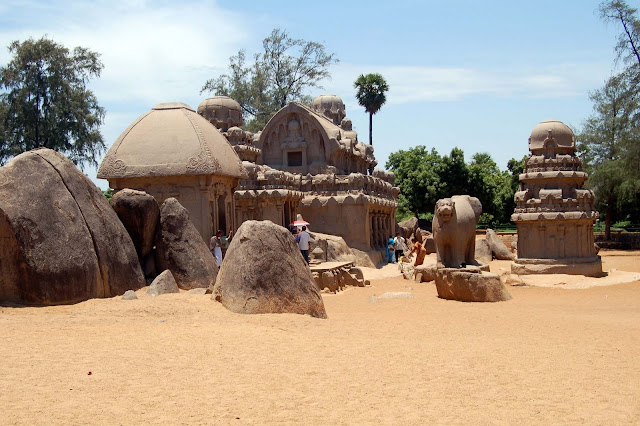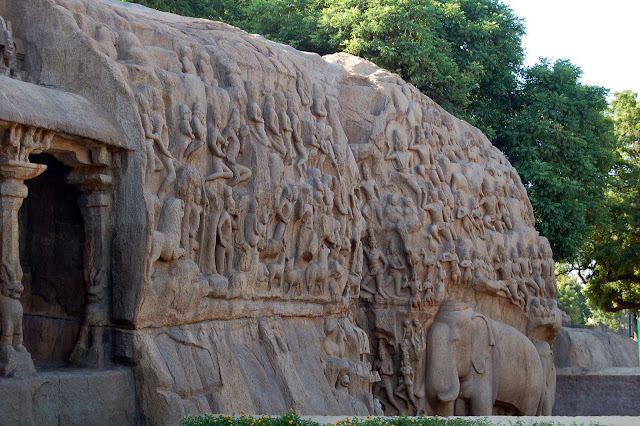Mahabalipuram India
Peble Jeine
This group of sanctuaries, founded by the Pallava kings, was carved out of rock along the Coromandel coast in the 7th and 8th centuries. It is known especially for its rathas (temples in the form of chariots), mandapas (cave sanctuaries), giant open-air reliefs such as the famous 'Descent of the Ganges', and the temple of Rivage, with thousands of sculptures to the glory of Shiva.
 |
| Mahabalipuram India |
Mahabalipuram is pre-eminently testimony to the Pallavas civilization of south-east India.The sanctuary, known especially for its rathas (temples in the form of chariots), mandapas (cave sanctuaries), and giant open-air reliefs, is one of the major centres of the cult of Siva. The influence of the sculptures of Mahabalipuram, characterized by the softness and supple mass of their modelling, spread widely (Cambodia, Annam, Java).
Founded in the 7th century by the Pallavas sovereigns south of Madras, the harbour of Mahabalipuram traded with the distant kingdoms of South-East Asia: Kambuja (Cambodia) and Shrivijaya (Malaysia, Sumatra, Java) and with the empire of Champa (Annam). But the fame of its role as a harbour has been transferred to its rock sanctuaries and Brahmin temples which were constructed or decorated at Mahabalipuram between 630 and 728.
Most of the monuments, like the rock-cut rathas, sculptured scenes on open rocks like Arjuna's penance, the caves of Govardhanadhari and Ahishasuramardini, and the Jala-Sayana Perumal temple (the sleeping Mahavishnu or Chakrin at the rear part of the Shore temple complex) are attributed to the period of Narasimhavarman I Mamalla.
The monuments may be subdivided into five categories:
- ratha temples in the form of processional chariots, monolithic constructions cut into the residual blocks of diorite which emerge from the sand. The five ratha of the south, which are the most famous, date to the reign of Naharasimhavarman Mamalla (630-68), the great Pallavas king (the Cholas texts, moreover, call the city Mamallapuram).
- mandapa, or rock sanctuaries modelled as rooms covered with bas-reliefs (the mandapa of Varaha, representing the acts of this avatar of Vishnu; the mandapa of the Five Pandavas and, especially, the mandapa of Krishna and the mandapa of Mahishasuramardini).
- rock reliefs in the open air illustrate a popular episode in the iconography of Siva, that of the Descent of the Ganges. The wise King Baghirata having begged him to do so, Siva ordered the Ganges to descend to Earth and to nourish the world. The sculptors used the natural fissure dividing the cliff to suggest this cosmic event to which a swarming crowd of gods, goddesses, mythical beings (Kinnara, Gandherya, Apsara, Gana, Naga and Nagini), wild and domestic animals bear witness.
- temples built from cut stone, like the Temple of Rivage, which was constructed under King Rajasimha Narasimavarmn II (695-722), with its high-stepped pyramidal tower and thousands of sculptures dedicated to the glory of Siva.
- monolithic rathas, from single- to triple-storeyed, display a variety of architectural forms, while the Dharmaraja, Arjuna and Draupadi rathas are square in plan, the Bhima and Ganesa rathas rectangular, and the Sahadeva ratha apsidal. Structural architecture was introduced on a grand scale by Pallava Rajasimha (700-28), culminating in the erection of the Shore Temple.
Another piece of architectural beauty is the Shore temple, standing against the background of the deep blue waters of the ocean. It belongs to a period when the constructional style of the Pallavas was at its peak in its decorative beauty and intrinsic quality. This building has become eroded by the corrosive action of seawater and air and the sculptures have become indistinct.



















Enter your first comment!